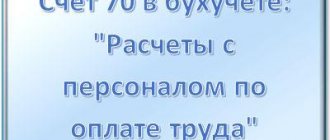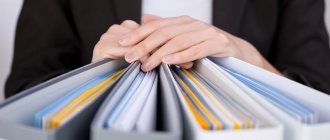What is account 20 in accounting
Account 20 is one of the registers in Section III of the Chart of Accounts. It summarizes information about the costs associated with the production of products (works, services).
Expenses
The main function of account 20 “Main production” is calculation, since it describes the economic process of manufacturing a product and collects all information about the costs of its production. Also, using an account card, you can track information about the movement of property in the enterprise.
The difference between this register and the others in accounting is that its balance at the end of the reporting period is not calculated using a formula, but is entered manually. This is due to the fact that cost information is collected on the account over a period of time (at least a month). Until the end of the period, the exact cost of the goods is unknown, since it includes many components - depreciation, wages for workers and management, utilities, transportation costs.
Thus, at the end of the reporting period (and necessarily at the end of the year), the account. 20, like production shops, is subject to inventory to identify work in progress. After this, the amount spent on the production of finished products (actual cost) is calculated, which is written off using one of the methods adopted by the enterprise’s accounting policy.
Meaning of account for accounting
This position in the Chart of Accounts, referred to as “main production,” is intended to summarize data on the costs incurred in the process of creating goods, works or services. In more detail, this position is used to account for costs such as:
- creation of goods for industrial and agricultural purposes;
- carrying out geological exploration, industrial construction and other works;
- services related to the organization of transportation and communications;
- carrying out research and development work;
- repair and maintenance of highways.
The debit side of the company reflects direct costs associated directly with the company's main activities, as well as indirect costs and expenses of auxiliary production. In the first case, expenses are written off to accounts where production inventories, employee payroll, etc. are taken into account. If we talk about auxiliary production, then in this situation there is a write-off to account 20 from the credit part of position 23, referred to as “auxiliary production”.
If at the end of the reporting period there remains a certain balance at the designated position, then it reflects the value of work in progress. As for analytical accounting, it is carried out taking into account the type of costs and the type of products produced.
What counts in the 20 count?
Account 20 is used to account for the following costs:
- production of products from agricultural and industrial enterprises, as well as subsidiary farms;
- costs of repair work, maintenance of cars and other vehicles;
- costs of organizations providing transport services;
- costs of construction, installation and design and survey work;
- costs of performing research and development work;
- costs of catering organizations;
- salaries of key and administrative personnel;
- depreciation of production equipment;
- amounts of payments for renting premises and paying for utilities;
- other expenses related to the activities of the production enterprise.
Debit 20 reflects all direct costs associated with the manufacture of products (performance of work and provision of services), costs of auxiliary production, indirect costs, as well as losses from defects. Credit 20 reflects the amount of the actual cost of goods, the production of which has already been completed, or work performed and services rendered.
Counting scheme 20
When determining the type of account 20 - whether it is active or passive - you need to understand the following: since the company cannot consume more raw materials and materials than it was written off for, therefore, debit turnover on the account. 20 will always be more credit. And this means that the count. 20 - active. Balance (remaining) according to account. 20 at the end of the month reflects the amount of work in progress costs.
How to close
Closing of account 20 occurs when the production of products is completed, work is performed or services are provided. To close the account, it is necessary to reflect it in the accounting entry for a loan for the amount of goods produced. Thus, after closing the account, it can either be reset to zero (if there are no other work in progress) or remain with a debit balance (if there is still work in progress).
Note! Account lending 20 does not always mean production is complete. If a defect is detected, it is also written off from credit 20 to debit 28 “Defects in production”.
Current legislation provides for the possibility of closing an account. 20 in one of three ways: direct, intermediate or direct implementation. The characteristics of the closing method must be spelled out in the accounting policy of the enterprise, and immediately before closing, the accountant must highlight the balances of work in progress, if any.
Direct method
This method is used when the actual price of manufactured products is unknown during the reporting period, so they are accounted for at conditional prices, mainly at planned costs. In the process of closing the account. 20 accounting department adjusts the cost of manufactured products to the actual cost.
With this closing method, accounting makes the following entries:
- Dt43 Kt20 - finished products are transferred to the warehouse at the planned cost;
- Dt90-02 Kt43 - writing off deviations of actual and planned cost to cost of sales.
Attention! When using this closing method, it becomes impossible to take into account the actual price of products during the month.
Intermediate method
When using this method, an account is additionally used in accounting. 40 “Product release”. This account reflects deviations of the planned cost from the actual one, while credit 40 includes the planned cost, and debit the actual cost.
Intermediate method of closing an account. 20
At the end of the reporting period, the total amount of the difference is written off proportionally to the account. 43 and 90-02. During the month, the accountant makes the following entries:
- Dt43 Kt40 - capitalization of finished products at planned cost;
- Dt90-02 Kt43 - write-off of sold products at planned cost.
How to close account 20 at the end of the month:
- Dt40 Kt20 - write-off of the actual cost of manufactured products;
- Dt43 Kt40 and Dt90-02 Kt40 are adjusting entries that bring the planned cost to the actual cost.
Direct implementation
This method of closing an account. 20 applies when the manufactured goods are not stored in a warehouse, but are immediately sold by the buyer. In this case, the costs are immediately written off to the cost of sales - Dt90-02 Kt20.
Accounting for a contractor's contract
When maintaining accounting records under a contract, you must be guided by the general rules of accounting.
Accounting for costs under a construction contract is carried out on account 20 “Main production”. This account reflects all the contractor's costs associated with the performance of work under the contract. If the contractor engages subcontractors to perform individual works, then the cost of the subcontracted work performed is also taken into account by the contractor on account 20.
Costs are written off as the completed work is delivered to the customer. The order of delivery of work is determined by the terms of the contract: as the entire volume of work is completed and the stage-by-stage delivery of completed work.
When handing over the work, as the entire scope of work is completed, the contractor's accounting of the contract considers the costs of the contract throughout the entire term of the contract. At the time of acceptance of the completed work by the customer (at the time of signing the acceptance certificate), accumulated costs are written off from account 20 “Main production” to the debit of account 90 “Sales”. At the same time, the contractual cost of the work performed is reflected in the credit of account 90 “Sales”.
Dt 51 Kt 62 - advance payment received from the customer for work
Dt 62 Kt 68 - VAT is charged on the advance received
Dt 20 Kt 10 (60, 70, 69, etc.) - reflects the costs of fulfilling the contract during the entire period of work
Dt 62 Kt 90 - reflects the cost of work performed
Dt 90 Kt 68 - VAT is charged on the cost of the sold object
Dt 90 Kt 20 - costs associated with the performance of work under the contract are written off
Dt 62 Kt 62 - the amount of the advance received is credited
Dt 68 Kt 62 - VAT paid on the advance is restored
Dt 51 Kt 62 - reflects the receipt of funds from the customer to the bank account for work performed
When the completed work is delivered in stages, the contractor's contract records reflect the implementation of the work for the completed stage. If the execution of work under a work contract continues for more than one reporting period, then it is reasonable to use account 46 “Completed stages for work in progress.”
Dt 51 Kt 62 - advance received from the developer for work
Dt 62 Kt 68 - VAT accrued on the contract from the advance received
Dt 20 Kt 10 (60, 70, 69, etc.) - reflects the costs of performing a separate stage of work
Dt 46 Kt 90 - reflects the cost of the stage of work completed by the contractor
Dt 90 Kt 20 - the amount of costs for completed stages of work is written off
Dt 90 Kt 68 - VAT is charged on the cost of the completed stage of work
Dt 68 Kt 62 - VAT has been restored from the advance payment for the completed stage of work
Dt 62 Kt 62 - the amount of the advance received is credited
Dt 68 Kt 62 - VAT paid on the advance is restored
Dt 62 Kt 46 - the cost of all stages of work has been written off
Dt 51 Kt 62 - reflects the receipt of funds from the customer to the bank account for work performed
The contractor can perform work using both his own materials and the customer’s materials. If the work is performed by a contractor using the customer’s materials, then the procedure for accounting for the contract in terms of materials is determined by the terms of the contract.
The contract may provide that materials for performing work are provided to the contractor by the customer with the cost of the materials provided offset against payment for the work performed by the contractor.
Debit 10 Credit 60 - receipt of materials from the customer is reflected
Debit 62 Credit 90 - reflects the cost of work performed
Debit 60 Credit 62 - mutual debts were offset
The contract may also provide for another option, when the materials transferred by the customer to the contractor remain the property of the customer. In this case, the contractor records the received materials in off-balance sheet account 003 “Materials accepted for processing.” As materials are used, the contractor writes off their cost from account 003.
Subaccounts
For account 20 the following recommended sub-accounts can be opened for the main activities of the enterprise:
- 20-01 “Crop production”. This takes into account the costs of crop production and its branches - horticulture, floriculture, growing seedlings.
- 20-02 “Livestock” - accounting for the costs of output from livestock farming and its industries - dairy and beef cattle breeding, sheep farming, fish farming, beekeeping, etc.
- 20-03 “Industrial production”. This subaccount reflects all direct costs associated with the manufacture of goods, preparation and development of production, other production costs, as well as production maintenance and management costs.
- 20-04 “Other main production” - cost accounting for other main activities of manufacturing enterprises.
Interaction with other accounts
Account correspondence 20 on debit is carried out with the following sections:
- Section 1 - 02, 04, 08.
- Section 2 - 10, 11, 16.
- Section 3 - 20, 21, 23, 25, 26, 28, 29-3.
- Section 4 - 40, 41, 43.
- Section 6 - 60, 68, 69, 70, 71, 73, 75, 76, 79.
- Section 8 - 94, 96.
On loan account 20 interaction with other accounts is carried out as follows:
- Section 2 - 1, 11.
- Section 3 - 21, 28.
- Section 4 - 40, 43.
- Section 6 - 76, 79.
- Section 8 - 90, 91, 94, 99.
Account postings 20
All transactions performed under debit 20 show the accrual, reflection and accounting of the cost of all materials and costs of manufacturing products.
Typical wiring
The correspondence with Section 1 reflects the inclusion of depreciation costs in the cost of production:
- Dt20 Kt02 - for products used in primary production and trade;
- Dt20 Kt04 - for depreciation of intangible assets;
- Dt20 Kt08 - construction costs are reflected.
Correspondence with Section 2 reflects the write-off of the cost of materials:
- Dt20 Kt10 - the cost of materials written off for main production is taken into account;
- Dt20 Kt11 - write-off of the cost of animals for the main production is taken into account;
- Dt20 Kt16 - writing off the amount of deviations in the cost of materials.
The correspondence with Section 3 reflects the inclusion in the cost of other types of expenses:
- Dt20 Kt20 - intra-production turnover of products;
- Dt20 Kt21 - transfer of self-made semi-finished products to the main production;
- Dt20 Kt23 - inclusion in the cost price of the cost of services of auxiliary production;
- Dt20 Kt25 - inclusion of overhead costs in the cost of production;
- Dt20 Kt26 - inclusion of general business expenses in the cost of production;
- Dt20 Kt28 - inclusion in the cost of losses from defects;
- Dt20 Kt29 - inclusion in the cost of production the cost of services of service industries and farms.
Correspondence with Section 4 occurs as follows:
- Dt20 Kt40 - write-off of planned cost;
- Dt20 Kt41 - transfer to the main production of goods purchased for sale;
- Dt20 Kt43 - supply of finished products for the needs of the main production.
Correspondence with Section 6 occurs as follows:
- Dt20 Kt60 - payment to third parties for services provided for the main production;
- Dt20 Kt68 - inclusion of taxes and fees in the budget in the cost of production;
- Dt20 Kt69 - calculation of insurance premiums for employees of the main production;
- Dt20 Kt70 - payroll;
- Dt20 Kt71 - payment of expenses of accountable persons for the needs of the main production;
- Dt20 Kt73 - inclusion of compensation for wear and tear of personal property in the cost of production;
- Dt20 Kt75 - contribution of the main production costs by the founders of the enterprise;
- Dt20 Kt76 - inclusion of insurance costs in the cost price;
- Dt20 Kt79 - inclusion of separate production costs in the cost price.
Correspondence with Section 8 occurs as follows:
- Dt20 Kt94 - inclusion in the cost price of the amount of identified shortages for various reasons (from damage to property, based on inventory results);
- Dt20 Kt96 - accrual from the cost of production of amounts to the reserve for future expenses (for repairs, vacation pay).
Note! Entries for credit 20 reflect the receipt of materials, waste, and finished products from the main production.
The relationship with Section 2 reflects the return of materials and supplies from main production:
- Dt10 Kt20 - taking into account unused materials and waste.
- Dt11 Kt20 - increase in the cost of animals due to weight gain.
Correspondence with Section 3 accounts occurs as follows:
- Dt21 Kt20 - receipt of self-made semi-finished products from the main production;
- Dt28 Kt20 - reflection of losses in the cost of irreparable defective products.
Correspondence with Section 4 accounts:
- Dt40 Kt20 - write-off of the actual cost of manufactured products;
- Dt43 Kt20 - posting of finished products.
Capitalization of finished products
The relationship with the accounts of Section 6 reflects:
- Dt76 Kt20 - reduction in the cost of work in progress;
- Dt79 Kt20 - performance of work by the main production.
Correspondence with Section 8 occurs as follows:
- Dt90 Kt20 - write-off of actual cost;
- Dt91 Kt20 - write-off of works or services of the main production;
- Dt94 Kt20 - reflection of the amounts of shortage of work in progress identified during the inventory process;
- Dt99 Kt20 - the costs of the main production are attributed to the losses of the enterprise.
Possible correspondence of account 26
According to the Chart of Accounts (order of the Ministry of Finance of Russia dated October 31, 2000 No. 94n), the following correspondence with account 26 is possible:
| Dt | CT | Wiring Description |
| 26 | 02 | Accrued depreciation of fixed assets |
| 04 | Intangible assets written off | |
| 05 | Depreciation of intangible assets accrued | |
| 10 | Materials written off for administrative needs | |
| 16 | Differences and deviations in the cost of inventory items are written off | |
| 19 | VAT is reflected on the services of third-party organizations and suppliers | |
| 21 | Semi-finished products produced by the company were written off | |
| 23 | Costs written off from auxiliary production | |
| 29 | Costs servicing production were written off | |
| 43 | Finished products written off for administration needs | |
| 60 | Settlements with counterparties-suppliers are reflected | |
| 68 | Taxes accrued (for example, on management property) | |
| 69 | Insurance premiums accrued on the salary of the management staff | |
| 70 | Administrative staff wages accrued | |
| 71 | Accountable amounts written off | |
| 76 | Settlements with other counterparties are reflected | |
| 79 | Settlements with branches that are on a separate balance sheet are reflected | |
| 94 | Losses from damage to inventory items are reflected | |
| 96 | Reserves for future expenses are taken into account | |
| 97 | Expenses of the following periods are written off | |
| 08 | 26 | Costs of non-current assets (for example, for the maintenance of the developer’s management staff) have been taken into account. |
| 10 | Materials returned from general economic circulation are accepted for accounting | |
| 20 | AUP costs are included in the cost of production | |
| 23 | Administrative expenses are included in auxiliary production | |
| 28 | Deficiencies from defective goods and materials are reflected | |
| 29 | Administrative expenses are reflected as part of costs servicing production | |
| 76 | Compensatory reimbursements for management expenses from various debtors/creditors are reflected | |
| 79 | Settlements with company branches are reflected | |
| 86 | General business expenses are taken into account in target financing | |
| 90 | Administrative expenses are written off to cost of goods sold | |
| 97 | Expenses are included in deferred costs | |
| 99 | Expenses written off as part of the company's losses |
In this case, the leash Dt 26 Kt 26 is not provided for in the Chart of Accounts.









